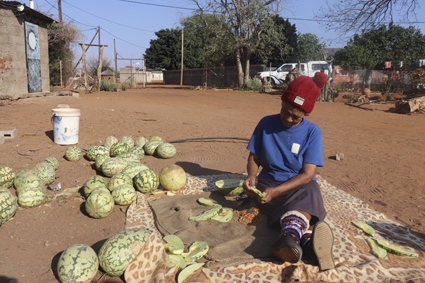Sesoswane Tswapong snack of choice
04 Oct 2020
Sesoswane seeds, a much loved and tasty snack in the melon family, is not as abandant as before in the Tswapong area.
Though some people still make sure that every ploughing season they plant it alongside other crops like sorghum, beans and maize, some do not regard it like before.
Sesoswane is a small melon whose seeds are roasted and can also be pounded and be made a component of a couple of other meals. Looking at sesoswane, one might confuse it with watermelon because they look alike.
On the inside, sesoswane melon is yellowish, while the seeds are an off-white colour.
Ms Ndishebo Seshekane (88) from Borotsi is one of the farmers who still plant sesoswane because she still believes that ploughing is not complete without the melon.
In every ploughing season, she makes sure that she has sesoswane seeds. When she was growing up, sesoswane, which has clearly been around for many years, was more abundant than it is today, and many people then used to plant it in large quantities. Its seeds, from which cooking oil can also be extracted, have many uses as in addition to human consumption of the seeds, the flesh and skin of the melon can be used as livestock feed.
The snack itself can be enjoyed in many ways.
“It can be fried and eaten on its own as a snack. It can also be mixed with dried maize (kabu) and be eaten or it can be pounded and mixed with other foods like morogo wa dinawa or pounded meat and also makes delicious soup,” she explains.
Ms Seshekane remembers an incident when she pounded sesoswane and made soup for her grandchildren and they instantly fell in love with it.
“After finishing what I had served them, they kept asking for more. They just couldn’t have enough of it. That’s how we used to enjoy it when growing up. The soup would be served with porridge for a really fulfilling meal,” she says.
Ms Seshekane also recalls the times when she used to sell traditional beer at her home and she would have a bowl of roasted sesoswane at hand.
“My patrons really liked enjoying mouthfuls of sesoswane in between sips of traditional brew. Any report that the sesoswane was finished would cause an uproar of complaints of why I had roasted only so much,” she notes.
In the days when the melon was still a lot popular, families used to enjoy it in the evenings when sitting around the fire.
Some would carry pockets full of the roasted seeds when going about their daily affairs such as when they went out to herd livestock.
To extract the sesoswane seeds, one has to identify the fully developed melons and then cut them open to remove the seeds, after which they are dried before they could be fried or pounded to be used as a component of some meals. Although Ms Seshekane is pleased that some people still plant and eat sesoswane, the fact that some traditional foods get discarded as the nation evolves worries her.
She is worried that Tswapong’s most loved snack will soon belong only in history books, joining countless other types of food that are now scarce or have completely disappeared.
“I am afraid that sesoswane will vanish because it used to be found in abundance but things have since changed,” she observes.
One of the elderly women in Lerala, Ms Grace Motsamai concurs with Ms Seshekane that sesoswane is not as popular as it used to be in the past.
With the number of people planting it declining, the few who still do only produce just enough for consumption at family level.
To Ms Motsamai, sesoswane will remain an all-time favourite snack.
The old woman, who often roasts sesoswane for her family to snack on after their evening meal; hopes that more and more people, especially the younger generations would resuscitate the love for the melon and hold on to it.
Ms Leaduma Gagoitsewe, 45, is one of the few people in Tswapong area who benefits from selling sesoswane.
Like others in the area, she ploughs sesoswane every ploughing season and sells it in the village.
Normally for her and others who sell it, a cup of raw sesoswane seeds goes for P5.00 and it can also be sold in bigger containers and the price would increase accordingly.
Despite the general reluctance to plant sesoswane, she is amazed that many still like it.
“Each time I have sesoswane, people would really be eager to buy it.
As for first time buyers of the roasted seeds, one thing they always do is ask for the recipe for preparing sesoswane,” she notes.
Ms Gagoitsewe believes that if taken seriously, sesoswane can generate some income for a lot of people in the area especially women.
Though trying to find the melons can be a cumbersome exercise in Tswapong villages, it is clear that many people have at some point in their lives had a taste of the seeds particularly as a snack, and this goes to show what a common food item sesoswane used to be in recent years. ENDS
Source : BOPA
Author : Portia Rapitsenyane
Location : BOROTSI
Event : Interview
Date : 04 Oct 2020







